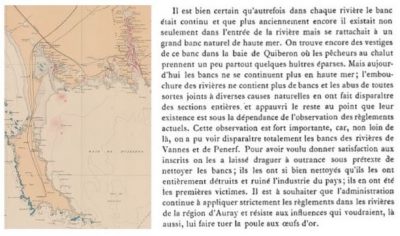A history lesson
PDFIn the world, there are more than thirty species of oysters, but not all are farmed. In France, currently, it is the Pacific oyster, Crassostrea gigas, which ensures the quasi-totality of the national production (80 000 tons per year). The connoisseurs know that another oyster, the flat oyster, Ostrea edulis, locally called Belon, Gravette or Pied de Cheval, deserves a particular attention. Representing only 2000 tons per year in the current French production, the flat oyster is the native species of our European coasts and it is this species which in the past, since the Gallo-Roman period, has supported a good number of families of sailors, fishermen and then oyster farmers. Overexploited by fishing since the 18th century, many shoals of flat oysters, which used to dominate the European coastline and especially the Breton coasts, disappeared in the 19th century (see Figure 1, [1]), which earned the term “underwater deforestation” denounced by Möbius, in 1877, one of the fathers of modern ecology.
In the 20th century, the development of modern oyster farming was not enough to save the species, weakened by the emergence of a first disease in the 1920s, a probable virus that was poorly identified. The farms and the industry were finally struck down by a first parasite (Marteilia) and then a second (Bonamia) which appeared successively from the 1970s. These parasites also spread like wildfire among the last wild beds. The flat oyster, which is 200 million years old, is now on the European list of species and habitats to be protected under the OSPAR Convention. Since 2012, various European countries, including France, grouped together in an alliance (NORA) since 2018, have begun to take steps to restore and reintroduce the oyster to European coasts. But the eventful history of the oyster in France does not end there.

Its cousin, the present-day Pacific oyster, Crassostrea gigas, was imported from Japan at the end of the 1960s to replace another oyster, Crassostrea angulata, which originated in Portugal! In fact, in the 19th century, in order to meet market needs and to deal with the overexploitation of the native flat oyster, Portuguese oysters were regularly imported. Incidentally, studies show that the Portuguese oyster is in fact native to Asia, more precisely Taiwan, and was probably introduced by the first merchant ships in the 16th century [2].
But let’s go back to our French history. In 1867, the Morlaisien, a ship from Lisbon, loaded with “Portuguese” oysters, was forced by a storm to dump its cargo in the Gironde estuary. A few years later, the cargo had made many children, from the Vendée to the Arcachon basin! In 1920, the “Portuguese” even began to supplant the native flat oyster in the basins of the South-West. The production of the latter quickly reached 60,000 tons, before suddenly collapsing in the 1960s, also decimated by a virus [3].
The Pacific oyster, Crassostrea gigas, replaced the latter at short notice and the French production quickly reached 120 000 tons. Introduced from Japan in the South-Western basins, it was supposed not to cross the Loire River for reasons of thermal preference (it needs water at more than 18°C to reproduce), but this was without taking into account the global warming. Little by little, with each warm summer and with the transfer of oyster farms, the species has conquered a new ecosystem, more northerly each time, and successive heat waves now allow it to reproduce in Norway.
But since 2008, it is the oyster’s turn to be hit by unprecedented mortality crises, caused by a herpes-like virus and bacteria [4]. History is an eternal restart and this new species, which was thought to be invincible, seems to be inexorably following the path of its forebears. New victims of our repeated mistakes, amnesiacs that we are! So much so, that some professionals are considering reintroducing its former cousin, the “Portuguese”, betting on the possibility that the iridovirus, its killer of the past, has had the courtesy to disappear from our coasts after 50 years.
Notes and References
[1] Map by Joubin-Guerin -Etel https://sextant.ifremer.fr/Donnees/Catalogue#/map and text by Louis Joubin, Notes sur les gisements de mollusques comestibles des Cotes de France. La région d’Auray (Morbihan), extracted from the Bulletin de l’Institut océanographique de Monaco (n° 89, 15 January 1907).
[2] Huvet, A. et al (2000). Variable Microsatellites in the Pacific Cupped Oyster Crassostrea gigas and Other Cupped Oyster Species. Animal Genetics 31, 71-7
[3] Grizel, H. & Heral, M. (1991) Introduction into France of the Japanese oyster(Crassostrea gigas). Journal of the International Council for the Exploration of the Sea, 47, 399-403.
[4] Petton, B. et al. (2021). The Pacific Oyster Mortality Syndrome, a Polymicrobial and Multifactorial Disease: State of Knowledge and Future Directions. Frontiers in Immunology, 12, 630343 (10p.).




